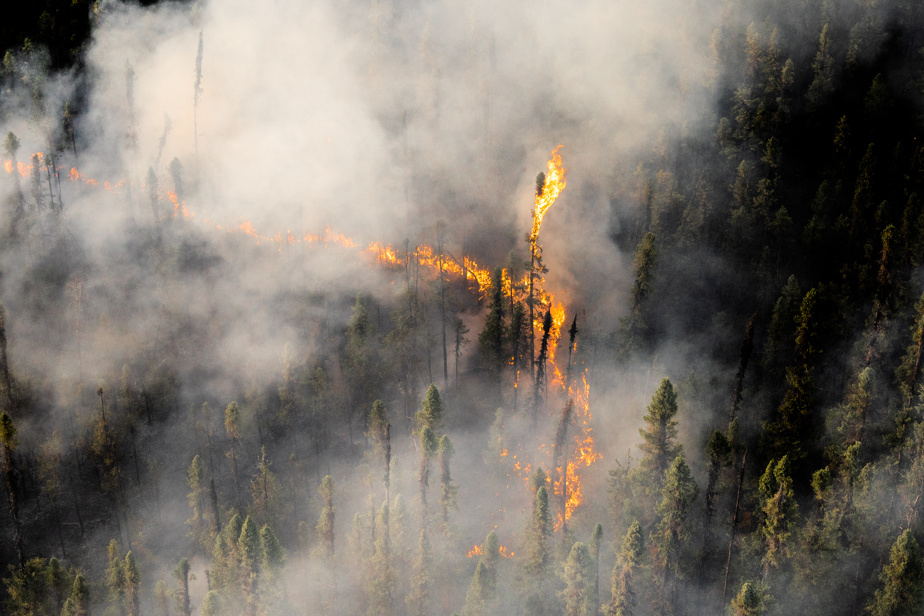Record fires in 2023

PHOTO MARTIN TREMBLAY, LA PRESSE ARCHIVES
A water bomber helicopter preparing to take off to try to contain a fire, in northern Quebec
In 2023, forest fires ultimately burned a record 4.5 million hectares in Quebec, nearly double the previous record set in 1989 with 2.3 million hectares burned. Between the months of May and August, the province experienced its hottest period since 1950, combined with a significant deficit of precipitation, particularly in the north of the province. A report from the World Weather Attribution network concluded last August that climate change had doubled the risk that weather conditions would favor such fires. Climate changes which have also made the severity of the 2023 fire season 50% more intense.
Review risk management

PHOTO MARTIN CHAMBERLAND, LA PRESSE ARCHIVES
The flames have wreaked havoc across Canada, such as here, on the Sturgeon Lake Cree reserve.
In a new study that has not yet been peer-reviewed, two dozen researchers call for “a comprehensive, unified approach to risk management that incorporates lessons learned from the 2023 fire season and accounts for change climate in progress”. “The fire season was exceptional, not only in Quebec, but also elsewhere in Canada,” underlines Yan Boulanger, forest ecology researcher at Natural Resources Canada and co-author of the study. “The impacts elsewhere in Canada are not necessarily the same as in Quebec and the solutions are not the same,” he adds, while emphasizing that these events will be more frequent in the future.
Provide a precautionary reserve

PHOTO MARTIN TREMBLAY, LA PRESSE ARCHIVES
Charred trees in the Abitibi-Témiscamingue region, near Senneterre and Lebel-sur-Quévillon
The first recommendation may be the most complicated to implement, but it is also the one which may prove to be the most profitable in the long term, notes Yan Boulanger. This involves taking fire risks into account when calculating forestry possibilities for industry, and not a posteriori, as is currently the case. Concretely, this means that the Chief Forester must provide a “precautionary reserve”, which translates into lower cutting rights each year. Currently, such a calculation is only revised a posteriori, with rare exceptions.
Put 20% aside to deal with unforeseen events

PHOTO MARTIN TREMBLAY, LA PRESSE ARCHIVES
Last summer, forestry workers in Abitibi cut down wood burned by a huge forest fire.
The precautionary reserve is a bit like putting money aside to deal with unforeseen events. But how much should we save each year to cope with the effects of climate change? The study suggests that a 20% precautionary reserve put in place 20 years ago for northwestern Quebec would have made it possible to avoid a reduction in logging after the fires of summer 2023. Such a strategy would also make it possible to harvest more wood in the medium and long term, underline the researchers. “It would bring more predictability for the industry and for communities in the long term,” says Yan Boulanger, who recognizes, however, that it is also necessary to convince the industry and the government of the advantages of such an approach.
Making the forest more resilient

PHOTO MARTIN TREMBLAY, LA PRESSE ARCHIVES
A road blockade was erected near Sept-Îles after a fire approached the north-coastal town last summer.
The other five recommendations aim to make the forest more resilient to the consequences of climate change, in particular by planting more jack pine, which reproduces more quickly and more easily than black spruce, for example. In some regions, when conditions permit, we could also consider planting more hardwoods, which are more resistant to forest fires. But none of these measures can have as much impact as our first recommendation, recognizes Yan Boulanger. “We have been trying to share this information for a long time. The office of the Chief Forester has also carried out studies on this, showing that due to the increase in fires in certain regions, it would be necessary to drastically reduce the allowable forestry to avoid stock shortages in a context of climate change. »
Read the study (in English)
